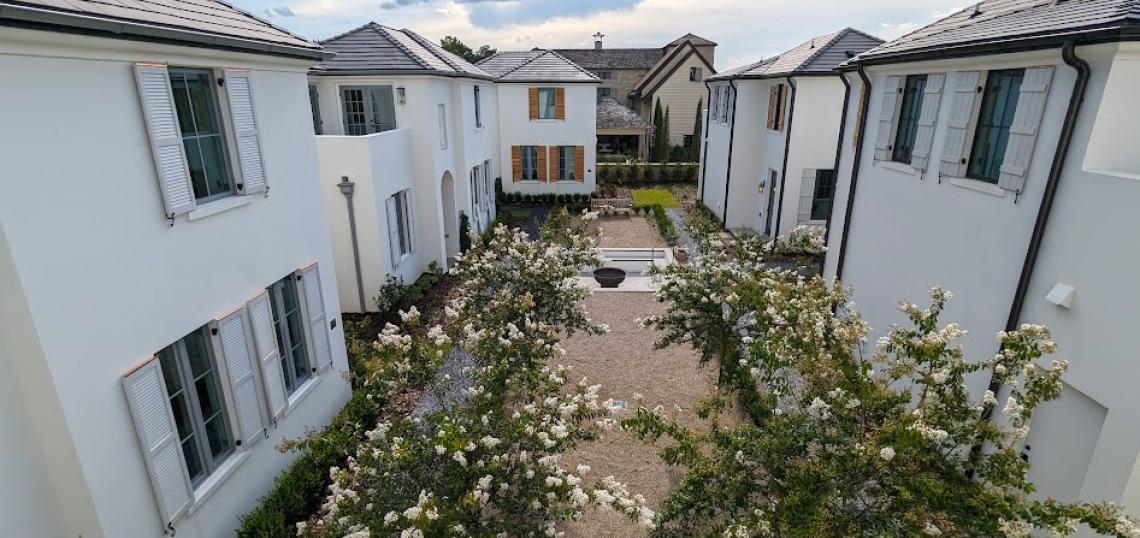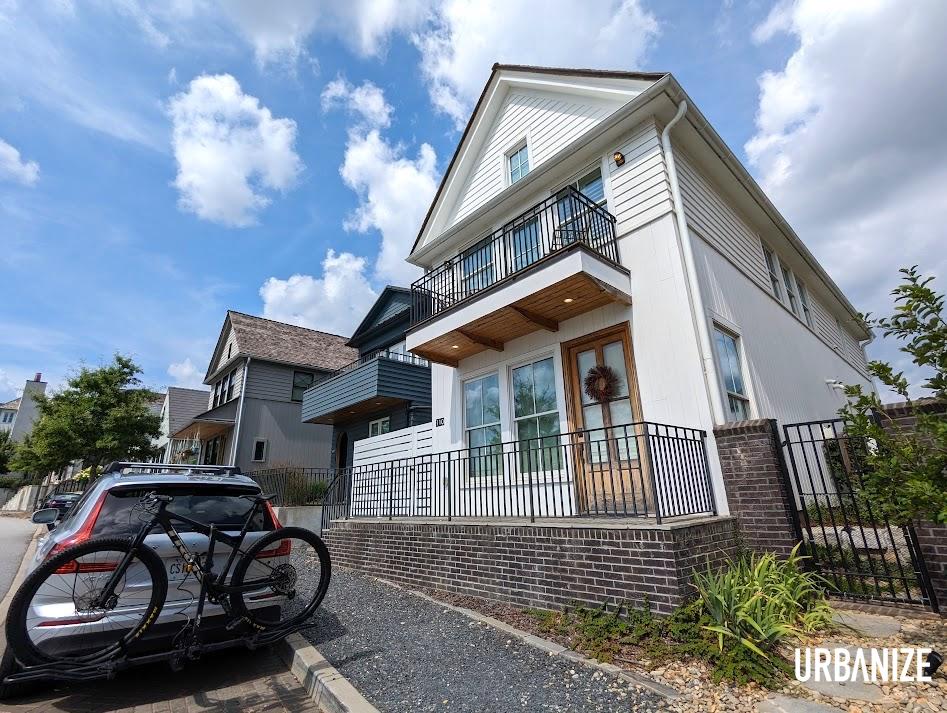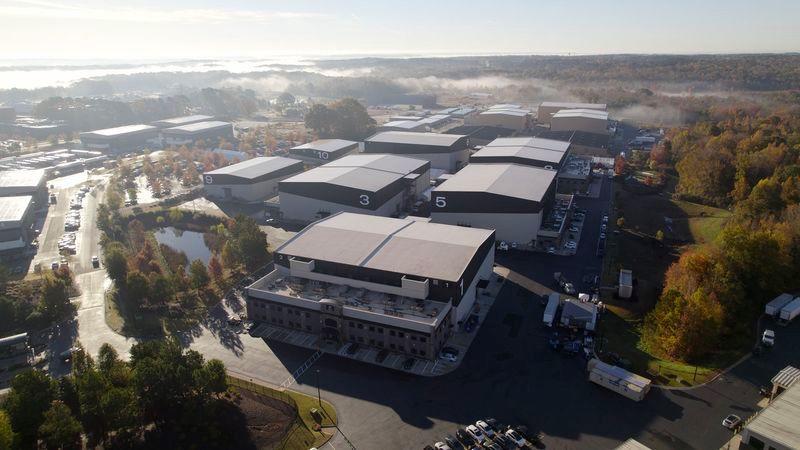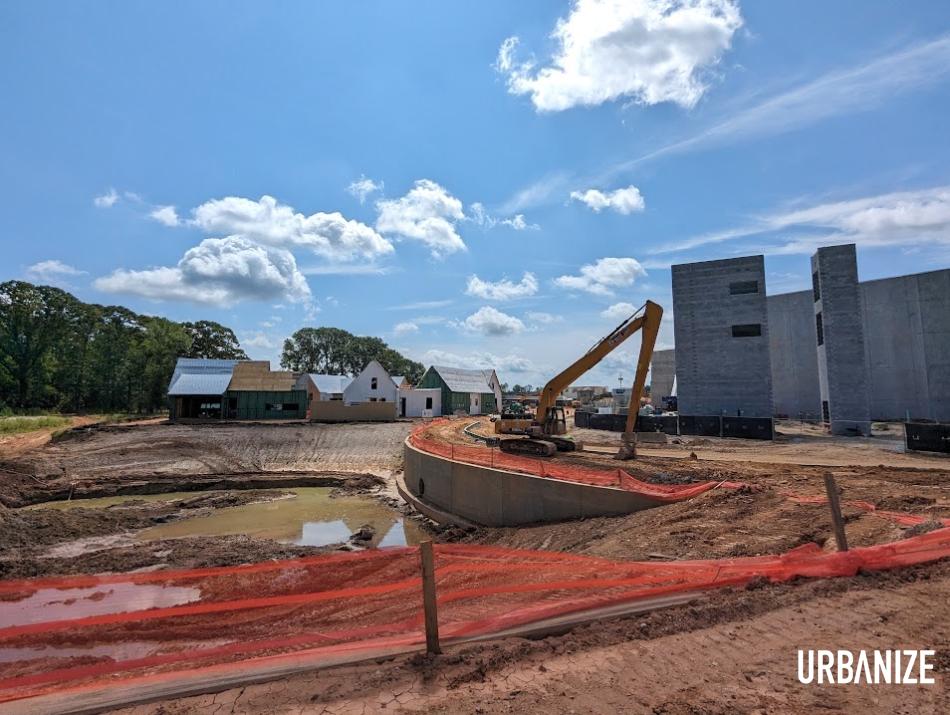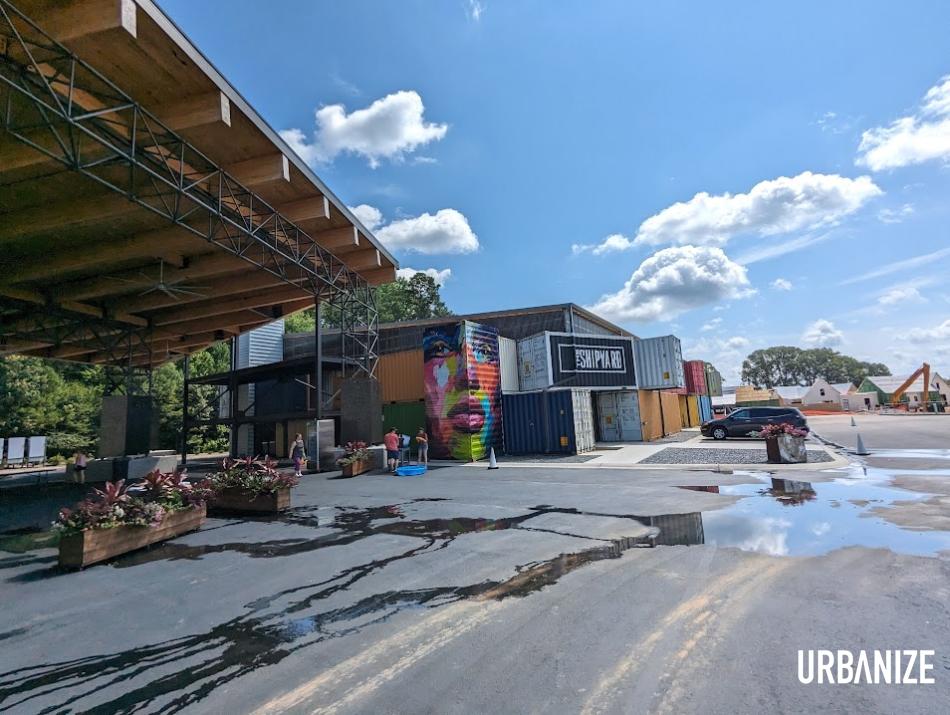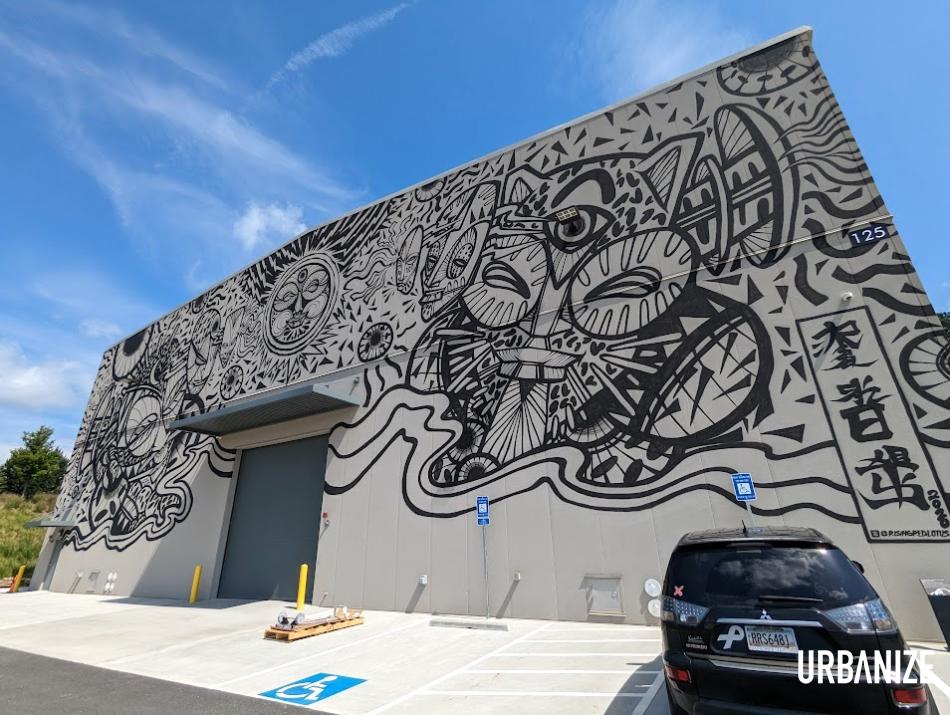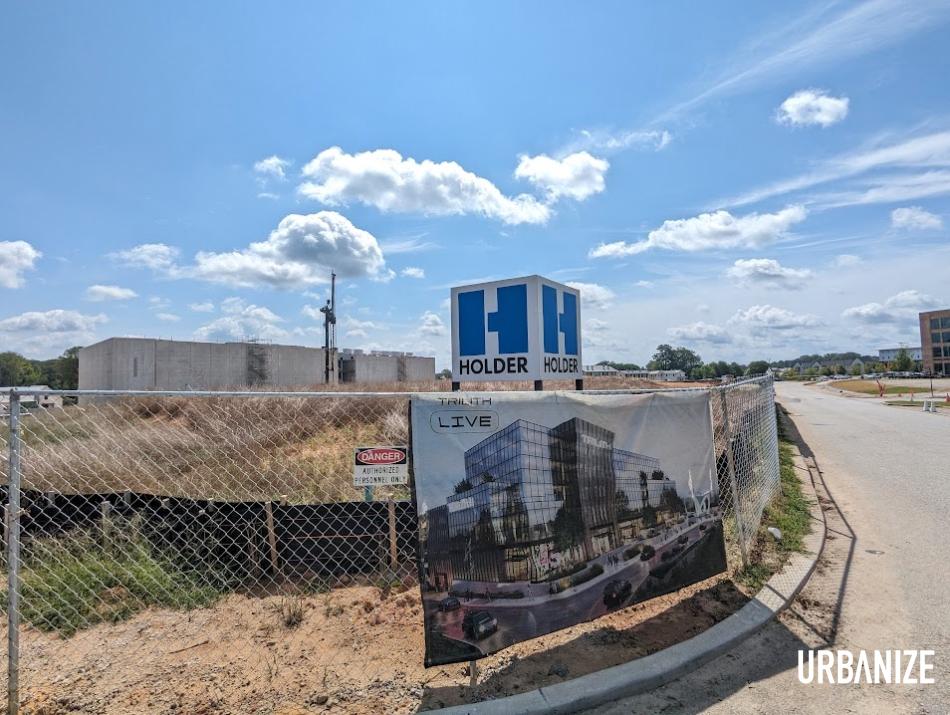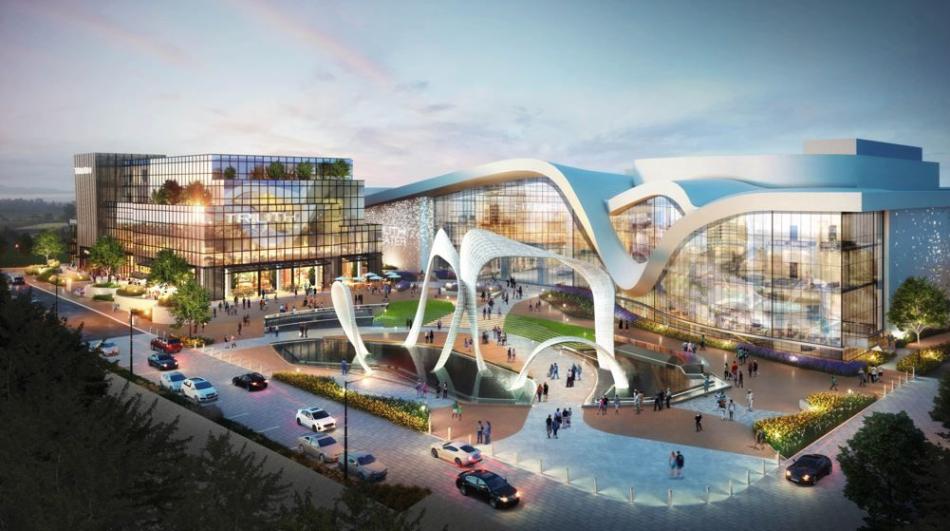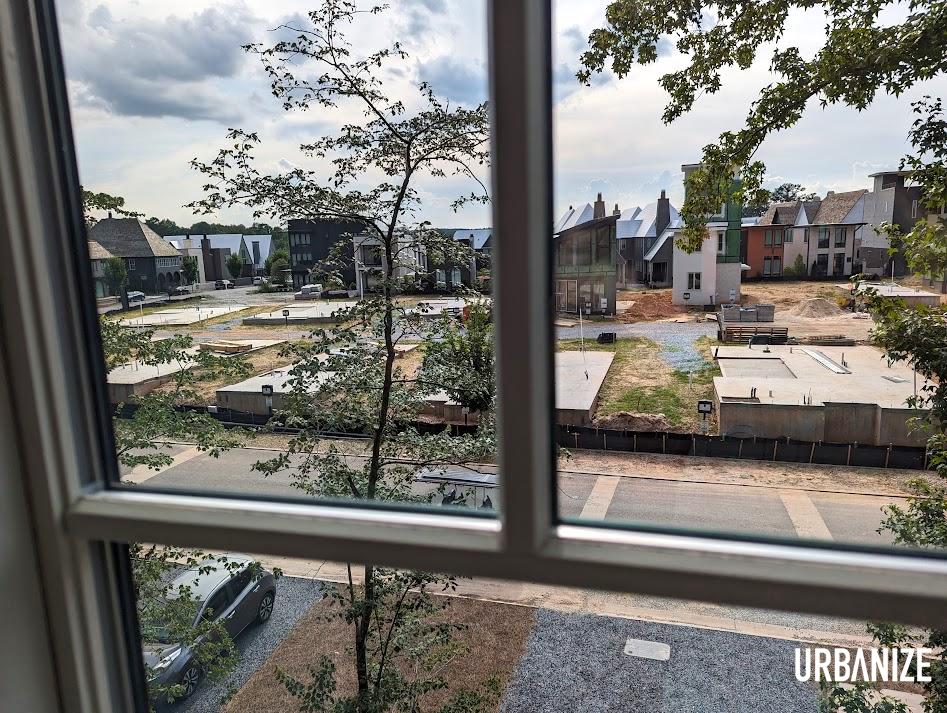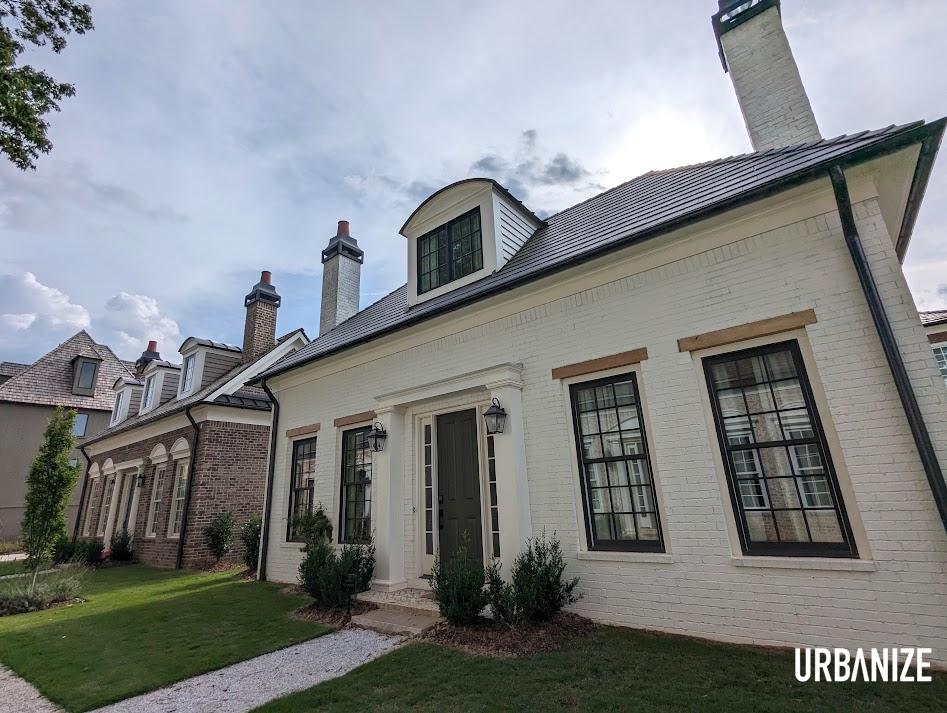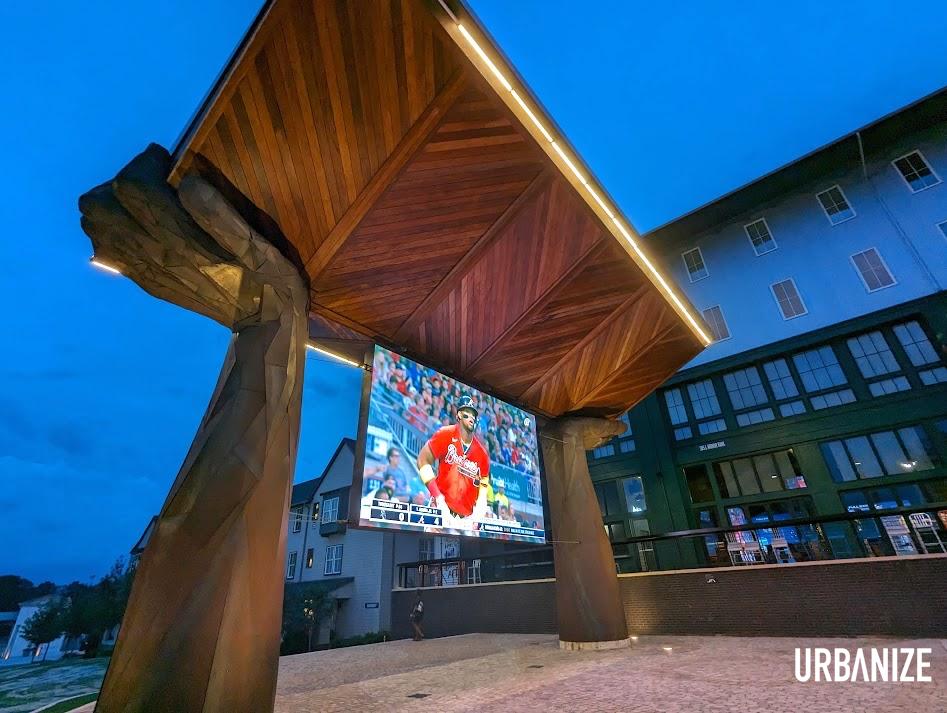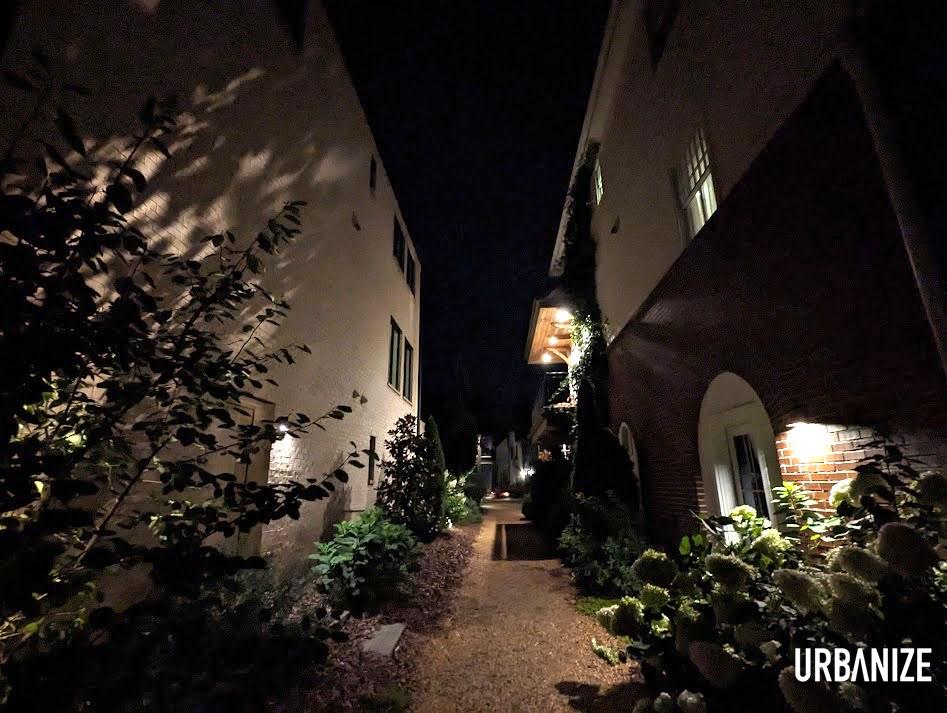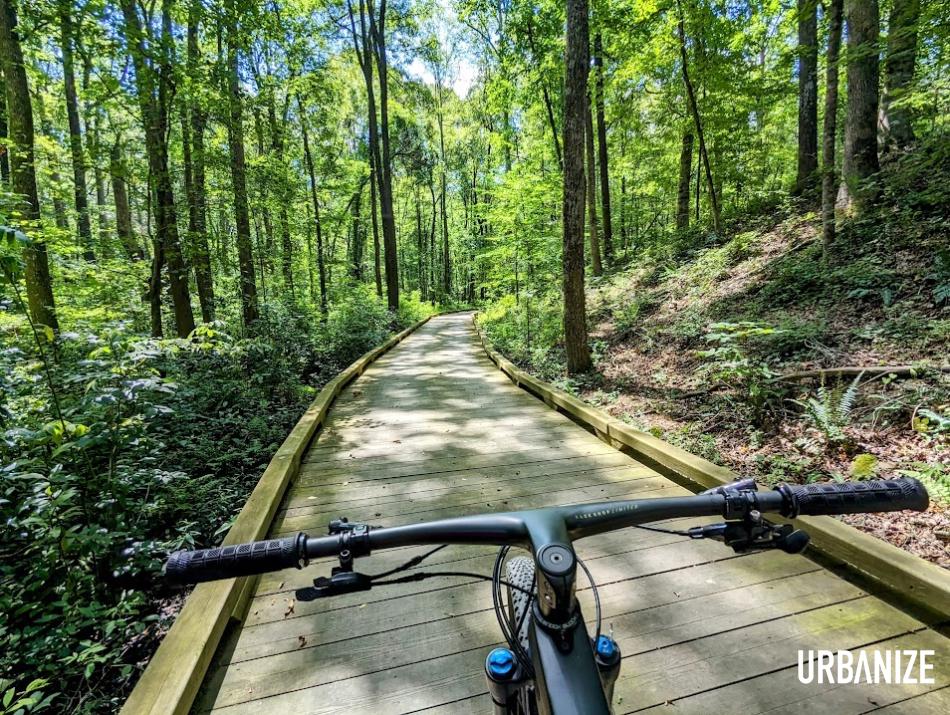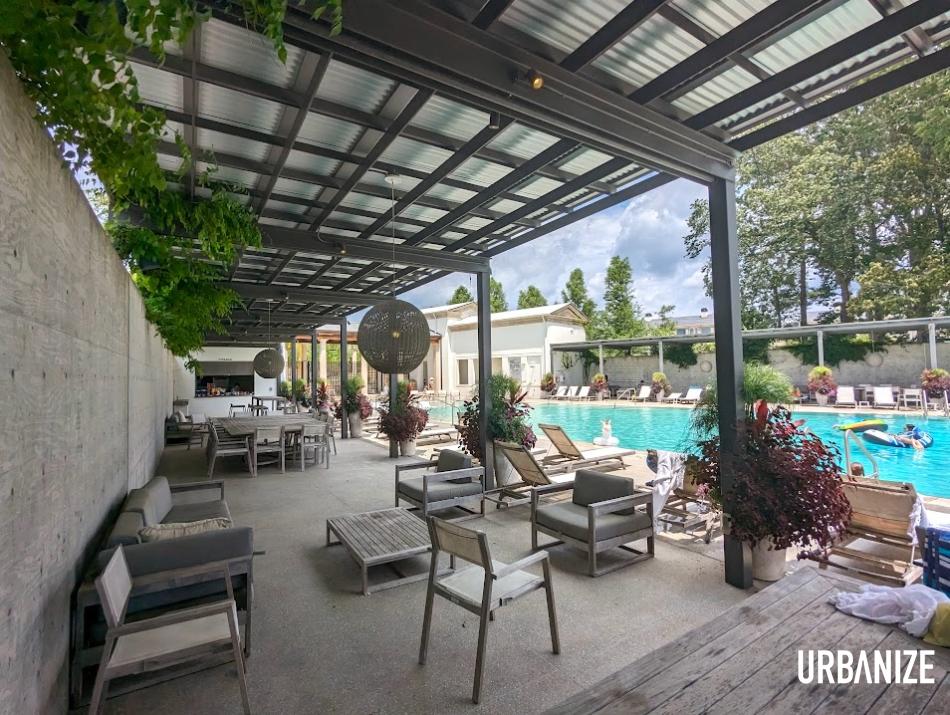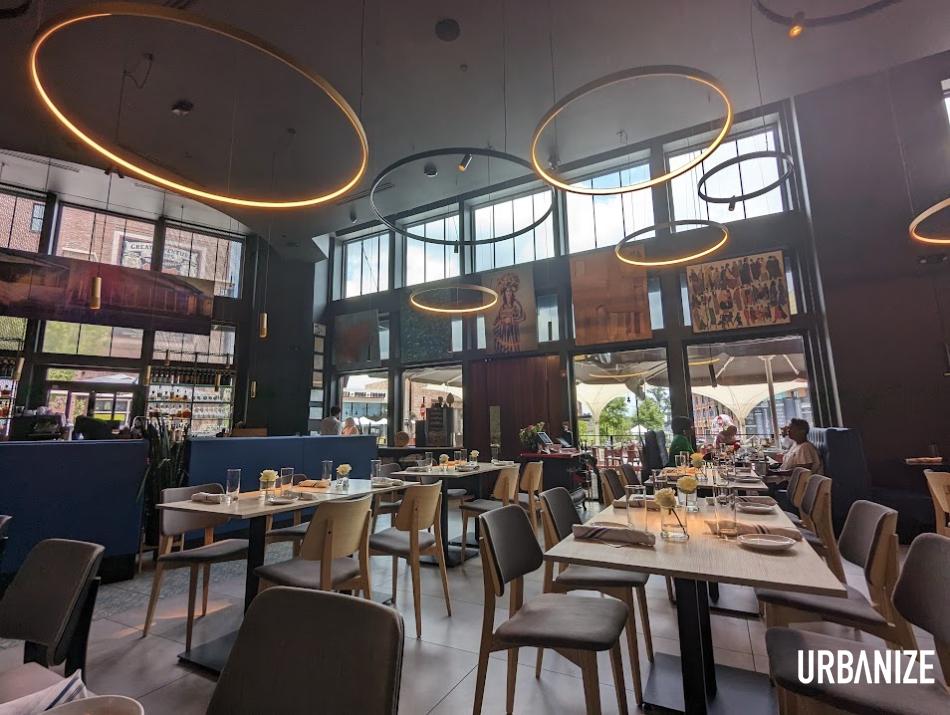Ant-Man’s autograph in the powder room pretty much set the tone.
We’d been at Town at Trilith for all of 45 seconds, having grappled with southside traffic molasses on a steamy Friday afternoon to arrive at what’s called the Heatherden House. A lovely modern farmhouse with an apple tree in front and courtyard off the kitchen, it’s owned by Trilith Studios across the street, which is expected to officially stake its claim as the largest TV and film complex in the U.S. soon.
That helps explain why a framed, signed photo of Paul Rudd and Atlanta rapper and actor T.I. was staring back at me as I darted to the loo for post-travel relief. Rudd, it turns out, has also stayed at Heatherden House. Chris Hemsworth was a big fan of a communal market staged down the street. The grassy hill across the way is where the “Battle of Wakanda” was filmed for Avengers: Infinity War. And that lake across the street is where Kanye West and family appeared to walk on water (it was actually metal scaffolding, built inches below the surface) during a Sunday Service ceremony that made global news. The oldest Trilith houses have been standing for only six years, but already this place has a storied history with some of the most influential entertainers of our time. Not bad for a New Urbanism experiment that’s proudly “situated among the wildflowers and farmlands of rural Georgia,” as a towering mural near the entry proclaims.
Trilith staff and media reps relayed these stories as we loaded into a deluxe Trilith-branded golf cart for an enlightening, in-depth afternoon tour. Each tale was fuel for my young daughters, two budding architecture aficionados who were hellbent on turning our 24-hour stay into some kind of celebrity safari.
It’s strange to write about a project for seven years without having set foot there, like trying to describe the ocean from Iowa. Way back when, we’d covered Town at Trilith’s groundbreaking on what had been, in ATL parlance, nothing: 235 acres of rolling agriculture fields near downtown Fayetteville, situated on a twisty road among horse pastures, about 20 minutes from Atlanta’s mega-hub airport. I’d corresponded dozens of times with project heads and spoken at length with the lead planner, award-winning architect Lew Oliver, who promised “beautiful urbanism” was coming when the place was still called Pinewood Forrest. A real estate agent and self-described city girl once told me, after she’d sold her family’s gorgeous Midtown bungalow during the pandemic and decamped to Trilith: “I tell people all the time it feels like a bubble here, like the way things should be, and it makes no sense to me why I like it so much.”
But there’s nothing like spending time somewhere to know if everyone singing its praises—and paying top dollar, in many cases, to be here—is on point or a little bit crazy.
…
Trilith’s broader goal is to “redefine the modern American town,” forging a new kind of suburban community (like Serenbe before it, but denser) that prizes walkability and sustainability over easy SUV trips to Publix and Target. A place where hungry young creatives coexist with hip families, actors, directors, writers, and well-to-do retirees. Beyond kids, the youngest full-time Trilith residents have just graduated college, while the oldest at the moment are 95. “We’re not cool like Atlanta—we get that,” says Kim Chapple of the Trilith sales team. “But I think we’re this amazing hybrid of a thriving downtown and suburbia… [and] the growth is astronomical. We joke that you can go on vacation for a week, come back, and we have five brand-new homes.”
She ain’t kidding. One thing that’s immediately clear: Despite doom-and-gloom economic headlines and interest rates swelling like a naughty kid at Willy Wonka’s factory, new construction is still everywhere at Trilith, and nobody’s talking about slowing down.
The fifth phase of Trilith Studios is scheduled to open next month, meaning 32 different soundstages, most of them massive, will be spread across an expanding footprint of 740 acres—nearly the size of four Piedmont Parks stitched together. (By comparison, Tyler Perry’s sprawling TV and film complex isn’t half that size.) Once Phase 5 opens, Trilith reps say the studios where Avengers: End Game, Guardians of the Galaxy sequels, and Spider-Man: Homecoming were made will be larger than any other in the country. And plans are already cooking for a “Trilith South” studio expansion, which remains in tentative “dream phases” now but suggests that, for Hollywood, juice from those famous Peach State tax credits remains sweet as ever.
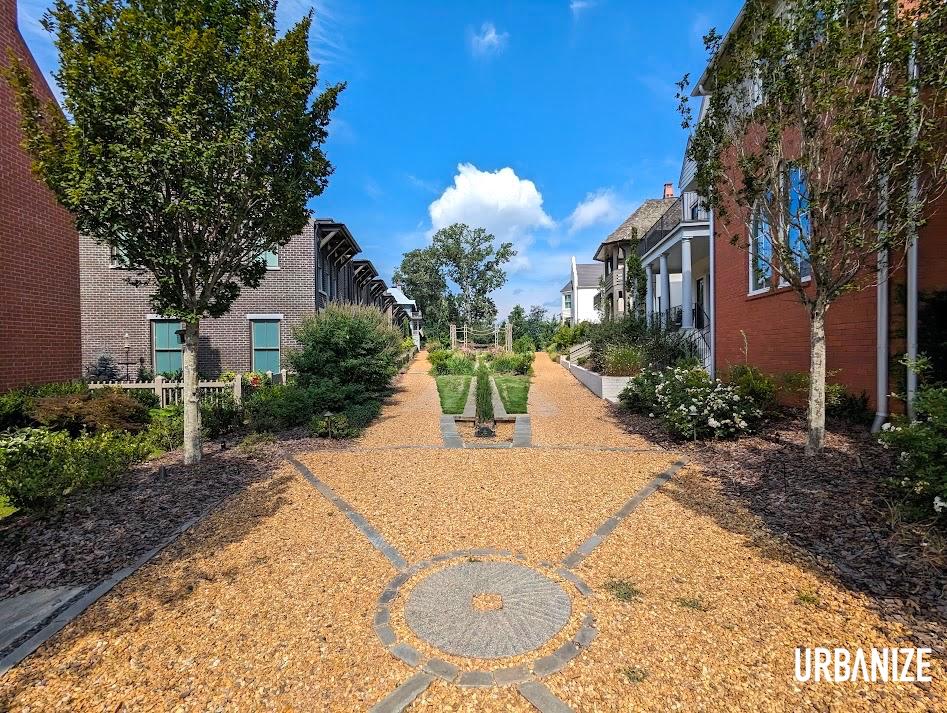 Fun fact: This stone at the edge of a triangular Trilith park was sourced from an old Georgia gristmill. Josh Green/Urbanize Atlanta
Fun fact: This stone at the edge of a triangular Trilith park was sourced from an old Georgia gristmill. Josh Green/Urbanize Atlanta
Meanwhile, the Town at Trilith portion has completed and sold about 300 European-inspired homes (30 percent more than two years ago) alongside 600 apartments. Somewhere in the ballpark of 1,000 people now live here full-time. Brett Baker, Trilith’s director of residential construction, practically quakes with excitement in discussing plans for the next huge flank of housing expected to break ground in the first quarter of 2024. That’ll bring another 350 houses in seven different architectural themes, each designed to unveil surprises—say, a communal hammock, outdoor kitchen, pocket parks, or an opulent secret fountain—for people simply walking around and exploring. Trilith’s horseshoe shape is designed to ensure, no matter where you are, you’re no farther than a 10-minute walk from its commercial core.
“What’s really good about this place is you have homes at various price points and they blend—nothing is segregated,” says Baker, captaining the golf cart on a sauna afternoon, my kids seat-belted in the back. “I’ll show you tiny homes next to probably some of the most expensive homes that are here. It’s really cool.”
Sounds good—let’s roll.
 Map of Trilith's commercial section (bottom) and first phases of housing (top right), where 22 homes remain to be built. Courtesy of Trilith
Map of Trilith's commercial section (bottom) and first phases of housing (top right), where 22 homes remain to be built. Courtesy of Trilith
…
With Marvel’s growing film mecca in the distance, we circled on slate-chip pathways around the lake and a dog park that Trilith founder Dan Cathy—the Chick-fil-A billionaire who announced these companion concepts in 2016 on land near where he grew up—requested be made “Instagrammable.” We’d be remiss not to note that Trilith endured negative national publicity last year, and Cathy was named in lawsuit alleging racist behavior among some Trilith residents that project leaders have vehemently denied. In talks with residents, employees, and guests, we found the community to be diverse and accessible to the public, almost the anthesis of a gated subdivision, with an open-container policy that adds to celebratory vibes. Which is by design. Even when Town at Trilith reaches full housing capacity, the expected 12 restaurants and 30 stores and shops will rely on patronage from nearby places like Peachtree City, Newnan, and Senoia. “We still want and need all of those other people to flock in,” says Chapple. “People love to just park their cars and be able to have that walk, [to] just get a cocktail do some shopping.”
En route to the Town Centre, the golf car wobbled beside a scenic, manmade creek and Thumbs Up Diner (the only location to serve alcohol, Baker notes), and we caught our first glimpse of a Trilith cornerstone project: the topped-out Portal Guesthouse, a 196-room hotel with a rooftop bar scheduled to open in early 2024.
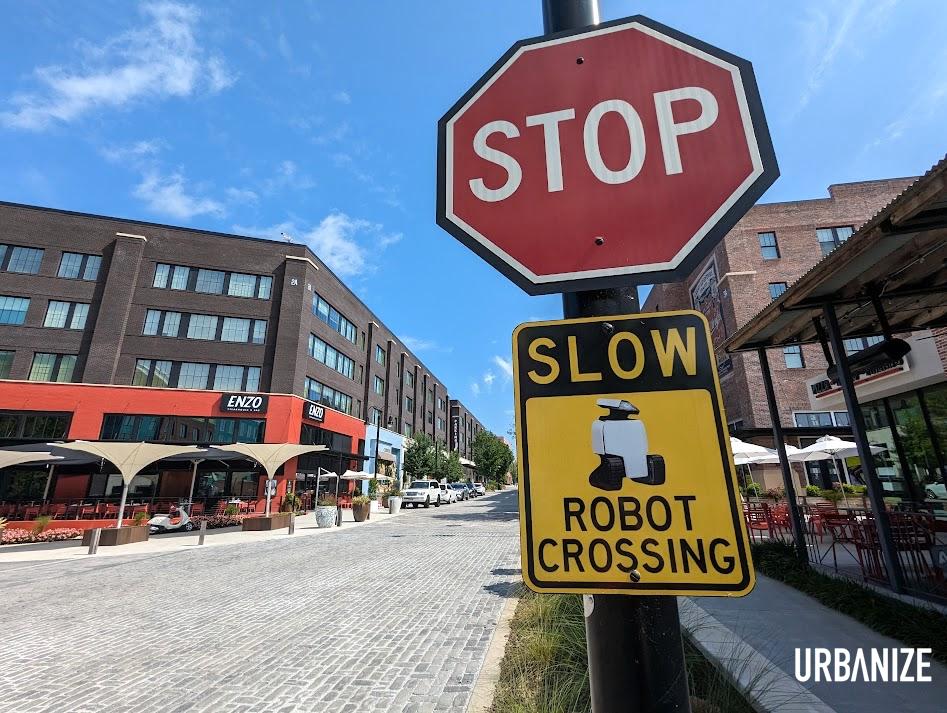 Signs of the times on Trilith Parkway, the community's main commercial thoroughfare. Josh Green/Urbanize Atlanta
Signs of the times on Trilith Parkway, the community's main commercial thoroughfare. Josh Green/Urbanize Atlanta
 Part of Trilith's 15-mile trail system beside the Piedmont Wellness Center. Josh Green/Urbanize Atlanta
Part of Trilith's 15-mile trail system beside the Piedmont Wellness Center. Josh Green/Urbanize Atlanta
Next we passed the multifaceted Piedmont Wellness Center, where tour leaders shared stories of NBA players recently working out alongside movie industry types, especially stunt doubles. “The Rock, when he was Black Adam,” says Baker, “his extras worked out here.” (The two girls in back noted all of that, shifting into high alert.)
We rolled by Trilith’s first food-and-beverage option to open, craft beer haven Barleygarden, near the Central Plaza, with its giant sculptural hands holding up an even more monumental LED screen. Trilith’s efforts to shout “creative hub” with eye-catching murals became apparent—most notably with a work by Atlanta artist by Brandon Sadler, said to be the largest mural in Georgia. That blankets a studio near the restaurants where Steve Harvey films Family Feud, next to a rainbow-colored event space built of shipping containers. Just beyond that is the rising village that is The Forest School, described as a K-12 micro campus with a focus on the arts and technology. Project leaders say that’s become a magnet for families (who can afford $11,500 annual tuitions per student) from across metro Atlanta and as far as California and New York.
Turning back toward the village, we pondered the beginnings of Trilith LIVE, a seven-acre venture that’s the town’s most ambitious project to date. Designs are still being tweaked, and the ETA remains TBD, but an 1,800-seat auditorium, nine-screen cinema with an indoor atrium and outdoor plaza, and a retail, creative office, and food hub are firmly in the mix.
“It’s going to be extremely unique,” says Cole Neely of Trilith’s Cookerly PR team. “Basically you’re taking a part of Vegas and putting it in south metro Atlanta.”
We breezed by the elegant pool complex—where Kim Kardashian once soaked up Vitamin D—and saw Central Park and the Great Lawn, greenspaces surrounded by large custom homes. For contrast, Baker led the way to a new micro village of two-story cottages in the Provence style, very South of France.
Despite footprints of 875 square feet and prices in the $500,000s, all six sold before completion.
“You seem to have no trouble moving all this product,” I say to Baker from the shotgun seat.
“It’s not as easy as it was, not with interest rates going up,” he replies. “The product I run out of quickest is the least expensive, the homes in the $500,000s. I need those homes. They’re putting in the infrastructure for [the next phase] now, so for a period of time my [lowest] price point goes up to $750,000.” (On the flipside, custom home prices now rise as high as $4 million-plus around here.)
Next came a tour highlight for all Atlantans on board. A row of more rustic four-story dwellings—the canopy homes, aka “treehouses”—are perched on a cliff overlooking wetlands. It’s a wild dichotomy here, like Blue Ridge meets a new-urbanist future. The top-floor balconies stand 55 feet over the forest floor—“When the leaves fall, you can see about 300 yards out there,” notes Baker—while out the front door, a distinctly modern, solar-powered new section of homes called Aurora is taking shape.
Like all Trilith homes, these are geothermal-powered, tapping deep into the earth for cooling and heating sources. Baker says it’s the largest geothermal community in the nation for now, until a larger project in Austin called Whisper Valley takes shape soon.
Entering the next project, a nook of Georgian-style dwellings around 550 square feet, Baker teased, “You’ve never seen a small home with a bedroom like this before,” before staring up at a tiny-house ceiling that must be friggin’ 18 feet tall. One of these recently sold to an actor who’d seen it only on the internet; he was most attracted to basement spaces in these layouts accessed through a secret portal in the floor.
All sweating profusely, we bolted into a large new village house with frigid A/C for the grand finale, which includes a garage, courtyard, and park views for around a million and ½ bucks. We hiked upstairs, to the deck, and admired the cedar-shake roofing. “We use very unique roofing, and unfortunately it’s very expensive,” Baker notes. “It’s not that we’re just trying to spend money frivolously—those details really do matter.”
The tour concluded, and we were free to hit the town. My kids’ minds, having absorbed each detail, were blown. They’d forgotten the celebrity safari. Ant-Man and company had just gone on strike anyway.
…
We attempted to follow Neely’s recommendation and try the art-bedecked ENZO steakhouse and bar, but it was booked for more than an hour, so it was off to the Barleygarden rooftop for a couple of Passion on Ponce IPAs and something fittingly called the Y’allywood Chicken Club. A furious storm blew in from the north with merciful wind but no rain. With it came that everything’s-all-right vibe of Friday night.
My wife actually ran into her hairdresser from East Atlanta, and we hung with her family (including her cool Fayetteville parents) as the Braves played on that gargantuan TV in the town square. Music spilled out of Fairway Social, the town’s sports-centric nightlife nucleus.
I began to notice what’s an almost telepathic level of planning around Trilith, in that there seems to be a trashcan at the ready just when you need it, a crucial drink ledge in the public restroom, and the right arrangement of manicured flowers down every view corridor.
As night fell, we waded through the communal frog pond and watched the master-planned mini-Europe glow to life. Walking back home through pathways that constitute part of Trilith’s 15-mile trail system, it dawned on me how whisper-quiet civilization can be without air-conditioner condensing fans beside each house—and what an aesthetic difference cobblestones, slate walls, and timeless brick can make. A beer-buzzed notation went into the voice recorder: “Feels like Wrigleyville in Chicago or something meets Spain. These alleyways connect with so many lovely patios. And it’s astonishing, the lack of sound, with so much density. All you hear are cicadas, bullfrogs, and crickets.”
A minute later: “Finally starting to shed the feeling I’m trespassing.”
As the town revived in the morning, we grabbed a bite at Woodstone Bakery and Café (get the house-made pop-tart with strawberry mango) and sat in directors chairs, watching hummingbirds sip honeysuckle. The family headed to the pool, and I beelined for the wetland trails. The chipped-slate pathways are sweet heaven on a cross-country style mountain bike.
After splashing around the Trilith pool (also horseshoe-shaped), it was time for lunch at ENZO, where the Northern Italy-inspired food is chef’s-kiss delectable as advertised. Pick either the most artful chicken and waffles of all time (with a mound of pistachio gelato in the middle) or the lamb burger with fingerling potatoes, and you’ll leave happy.
Speaking of leaving, duty called in Atlanta, and our time at Trilith and the Heatherden House concluded after 24 hours. We drove back north into green farmlands that gave little indication a teeming metropolis began a few minutes away. It felt like we'd visited some calmer, manicured universe for a day. I looked into the backseat and asked for reflections on the experience. The kids liked the architecture. The art components. And the stories about The Rock. “It exceeded my expectations,” said the eldest daughter. “I thought we were, like, going to stay in a hotel or something—in the middle of nowhere.”
Note: Find an array of snapshots from a day at Trilith in the gallery above.
...
Follow us on social media:
• Special report: 24 hours of living like Ric Flair in Buckhead (Urbanize Atlanta)





